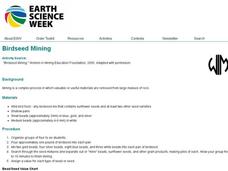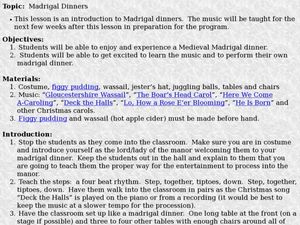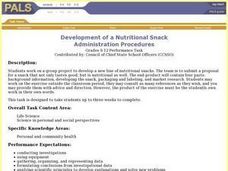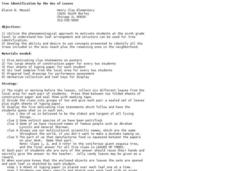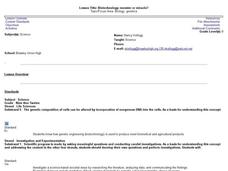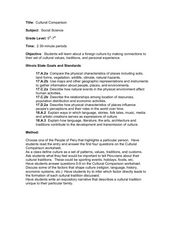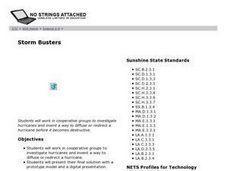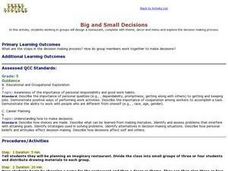Curated OER
What is Culture?
Students discuss "culture." In groups, they discuss and share things about their culture, recording everything they discuss on butcher paper to be hung around the room. They choose a way to share something about their own family...
Curated OER
Beautiful Bovine
Learners compare and contrast a human body to a cow. Using a diagram, they label and identify the functions of the cow's numerous parts. In groups, they create a Venn Diagram to compare the various types of cows with one another. They...
Curated OER
Birdseed Mining
Students explore the meaning of mining. In this Science/Math lesson plan, students engage in a small group activity to sort and calculate the value of seeds/beads. Additionally, they are made aware of environmental damages which...
Curated OER
Aztec Floating Gardens
Aztecs created amazing hydroponic gardens called Chinampas, to grow their crops. Learners in grades k-7 engage in four mini-experiments to understand just how amazing floating gardens are. Tip: A perfect way to bring science into your...
Curated OER
How Can We Keep Our Forests Intact and Have Our Chocolate Too?
Fourth graders explore various methods of growing and harvesting rainforest foods in order to sustain its biodiversity. They discuss the various uses for trees from several viewpoints. Students research chocolate demand and land use...
Curated OER
Eurovision
Students explore Europe's comples cultural identity. Students consider if one song could represent all pop music tastes of Europe. In groups, students plan an evening of entertainment. They design posters to promote the event.
Curated OER
Classified Information - Part 1: Shapes
Third graders investigate how and why scientists use classification. They discuss classification strategies using animals, and as a class fill in a flowchart with their responses. Next, in small groups they cut out a variety of shapes...
Curated OER
Genes: The Building Blocks of Life
Learners examine various topics on genetics. Students explore the Internet to gather information on genetic testing, genetically engineered food, forensics, DNA and cloning. They research and determine the best way to fund each of the...
Curated OER
Chemical Changes
Second graders investigate chemical changes and reactions and will identify four characteristics that indicate a chemical change. In this chemical change lesson plan, 2nd graders perform experiments that promote chemical changes. They...
Curated OER
Madrigal Dinners
Students investigate Medieval times. In this world history lesson, students discuss what a madrigal dinner was and what madrigals were. Students role play being a part of a madrigal dinner with pretend food and real life music they used...
Curated OER
Development of a Nutritional Snack
High schoolers develop a new line of nutritional snacks. They work in teams to submit a proposal for a snack that not only tastes good, but is nutritional as well. Their end-product consists of four parts: background information,...
Curated OER
Monsters of the Deep
Students describe major features of cold seep communities and list the organisms that are typical in these communities. In this deep sea environment lesson students work in groups and research their given cold seep group.
Curated OER
Science: Observing Fish Behavior
Fifth graders, working in pairs, select and observe fish in the Aquademics aguarium. They record their observations on worksheets and make graphs displaying the frequency of various fish behaviors. Students then discuss their...
Curated OER
Matter & Subatomic Particles
Seventh graders divide into small groups to construct several models. Each group builds with an accompanying chart showing the colors of gumdrops used for the protons, electrons, and neutrons.)
Curated OER
Tree Identification by the Use of Leaves
Young scholars explore trees and their leaves. In this tree identification lesson, students observe items and are able to identify them by the five clues they are given. Once the leaves are identified, young scholars in each group sketch...
Curated OER
The Solar System: Why do we Explore?
Third graders act as scientists. In this property discovery lesson plan, 3rd graders explore the substance "Oobleck" (cornstarch, water, food coloring). They work in groups to investigate the substance and make observations as a...
Curated OER
Sales Tax and Discounts
Middle schoolers explore the concept of sales tax and discounts. In this sales tax and discounts lesson, students pretend to gamble in groups to win fake money. Middle schoolers must tax their winnings. Students collect receipts. Middle...
Curated OER
Biotechnology: Monster or Miracle
High schoolers explore biotechnology. In this scenario-based lesson, students take a survey on what they know about genetic engineering, view a PowerPoint, and conduct a web quest. High schoolers will then be placed in groups, and...
Curated OER
Cultural Comparison
Students choose from a group of entries about the culture of Peru. In this Peruvian culture lesson, students understand the definition of culture. Students describe the culture of Peru researched in the entry and complete a worksheet.
Curated OER
What's On Your Plate?
Students explore the use of sensory details in writing. In this journal writing lesson, students write four journal entries after group discussion about a variety of topics such as their weekend, poverty in the United States, and...
Curated OER
Government: Government Intervention in Biomedical Research
Students are able to explain the role of government in protecting the rights of citizens. They participate in a lesson where they attempt to correct the ethical violations that were made in previous clinical trials such as the Tuskegee...
Curated OER
Storm Busters
Students investigate hurricanes and invent a way to diffuse or redirect a hurricane before it becomes destructive in this technology-based science project. Cooperative learning groups are emphasized.
Curated OER
Big and Small Decisions
Fifth graders design a restaurant and investigate how group members work together when making decisions.
Curated OER
Air Pressure is Powerful
Students construct a barometer and collect data on the changes in air pressure. They work is small groups using plastic tubing, corks, and green food coloring. They then use a formula to convert inches of mercury to barometric pressure...


